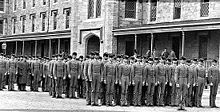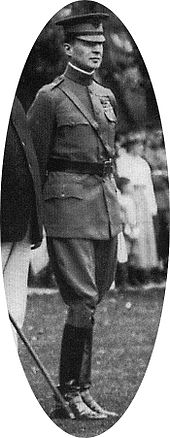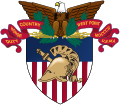History of the United States Military Academy
The history of the United States Military Academy can be traced to fortifications constructed on the West Point of the Hudson River during the American Revolutionary War in 1778. Following the war, President Thomas Jefferson signed legislation establishing the United States Military Academy (USMA) on the site in 1802. In 1817 the academy was transformed by the appointment of Sylvanus Thayer who drastically reformed the curriculum.
Revolutionary War and founding

The harsh winter of 1777–1778 froze the Hudson River, allowing elements of the Connecticut militia under the command of General Samuel Holden Parsons to march westward across the river. They first occupied West Point on 27 January 1778,[1] making it the longest continually occupied post in the United States.[2] George Washington considered West Point to be the most important military position in America,[3] stationing his headquarters there in the summer and fall of 1779.[4] After his victory over the British Army at the Battle of Yorktown, Washington kept the Continental Army garrisoned nearby at New Windsor at the New Windsor Cantonment until the official end of the war.[5] The original owner of the land at West Point was a General Stephen Moore of North Carolina. The Continental Army occupied his land for twelve years until Secretary of the Treasury Alexander Hamilton authorized the purchase of the land for $11,085 in 1790.[3]

Between 1778 and 1780,

The academy can trace its earliest roots to the 1776 Continental Congress authorization of the establishment of a "Corps of Invalids". This organization would "give service to disabled officers" with one its missions being to impart "military knowledge to 'young gentlemen'".[12] This "Corps" moved to the garrison at West Point in 1781, but few officers reported for duty and it was disbanded after the end of the war in 1783. In the years immediately following the Revolutionary War, West Point was the largest post in the army, with more than half of the approximately 100 authorized men in the entire army stationed there.[13]

During his presidency, George Washington realized a need for a national military academy to teach the art and science of war, but his Secretary of State Thomas Jefferson argued that there was no provision in the
Despite his earlier misgivings, when Jefferson became president, he called for and signed legislation establishing a "Corps of Engineers" which "shall be stationed at West Point and constitute a Military Academy" on 16 March 1802.[18] Jefferson wanted a "national university" that focused on science and engineering and was looking for an American with a strong scientific background to command the academy. In 1801, he found his man in Jonathan Williams. Though he had no previous military experience, Williams was a well-known scientist of his day, and a relative of Benjamin Franklin. Williams accepted Jefferson's appointment to the rank of Colonel and arrived to assume his post on 14 December 1801.[18]
Early years

The first graduates of the academy were Joseph Gardner Swift and Simeon Magruder Levy, who graduated on 12 October 1802. Swift would later return as Superintendent from 1812 to 1814.[20] Alden Partridge, an 1806 graduate, served as Professor of Mathematics and Engineering, and was Acting Superintendent on occasions from 1808 to 1813.[21] Partridge served as Superintendent from 1814 to 1817, and was responsible for selecting the gray uniforms students still wear today.[22] The early years of the academy were a tumultuous time, with few standards for admission or length of study. Cadets ranged in age from 10 to 37 and attended between 6 months to 6 years.[16] The impending War of 1812 caused Congress to authorize a more formal system of education at the academy, and increased the size of the Corps of Cadets to 250.[16] By the War of 1812, only 89 officers had graduated, morale was low, and the academy was in danger of being disbanded.[20] 1811 graduate George Ronan, assigned to duty at Fort Dearborn on the American frontier, was killed in the War of 1812 and became the first member of the Corps of Cadets to die in combat. Alden Partridge was accused of lax management and resigned his commission in 1818, unhappy at turning the Superintendent's position over to Sylvanus Thayer, who had been one of Partridge's students.[23] Partridge went on to found Norwich University.[24]
Thayer and his changes
After Thayer until the war with Mexico
After the tenure of Thayer, the academy faced challenges to its relevance as many new Western State congressmen saw it as a breeding ground for an elitist aristocratic Officer Corps. The War with Mexico, 1846–1848, changed the nation's perception of the academy. Because of the Army's slow promotion system of the time, no graduate of the academy had made general officer rank at the start of the war. However, many junior and mid-level officer graduates proved themselves invaluable in battle. Generals Ulysses S. Grant and Robert E. Lee first distinguished themselves in battle in Mexico. In all 452 of 523 West Point graduates who served in the war received battlefield promotions or awards for bravery.[28]
Mexican War until the Civil War


Robert E. Lee (class of 1829) was the Superintendent from 1852 to 1857. In 1857, West Point began the current process of admitting candidates nominated by the members of the United States Congress, one for each congressional district. The 1850s saw a modernization of many sorts at West Point, and this era was often romanticized by the graduates who led both sides of the Civil War as the "end of the Old West Point era". New barracks brought better heat and gas lighting, while new ordnance and tactics training incorporated new rifle and musket technology and advancement such as the steam engine. With the outbreak of the Civil War, West Point graduates filled the general officer ranks of the rapidly expanding Confederate and Union armies. Two hundred ninety four graduates served as general officers for the Union, and 151 served as general officers for the Confederacy. An astounding 10% of all graduates (105) were killed in action during the war, and another 15% (151) were wounded in action. Nearly every general officer of note from either side during the Civil War was a graduate of West Point.[29]
Post–Civil War until Spanish–American War
The years immediately following the
1900 to World War I
Between the world wars

The Interwar years saw the academy push to modernize to meet the demands of the emerging technologies in warfare. One of the academy's most distinguished graduates and a decorated WWI combat soldier and leader, Douglas MacArthur, became Superintendent in 1919. He instituted sweeping reforms to the academic process, introducing a greater emphasis on history and humanities.[34] He began the process of having instructors study at civilian institutions prior to serving at West Point and he provided more liberal leave and pass opportunities to the upper classes. He made major changes to the field training regimen and the Cadet Honor Committee was formed under his watch in 1922. MacArthur was a firm supporter of athletics at the academy, as he famously said "Upon the fields of friendly strife are sown the seeds that, upon other fields, on other days, will bear the fruits of victory". West Point became an officially accredited institution with the Association of American Universities in 1925 and in 1933 officially began granting the title of Bachelor of Science to all graduates. It was also just prior to World War II that the academy expanded the reservation boundaries, growing to the nearly 15,000 acres (61 km2) that it comprises today. In 1935, the United States Congress increased the Corps of Cadets to 1,960. As more cadets filled the barracks and classrooms, another building program was undertaken and completed by 1938.[35]
World War II to coeducation
Coeducation to present day
West Point first accepted women as cadets in 1976, when Congress authorized the admission of women to all of the federal service academies.
Academy coat of arms

Designed in 1898 by Professors Larned, Bass, and Tillman,
Notes
- ^ Crackel (1991), page 41.
- ^ Palka (2008), page viii.
- ^ a b Ambrose, page 10.
- ^ Neff, page 127.
- ^ "New Windsor Cantonment State Historic Site". New York State Office Parks, Recreation, and Historic Sights. Retrieved 13 February 2009.
- ^ Crackel (1991), page 44.
- ^ Crackel (2002), page 13.
- ^ Crackel (1991), pages 37–45.
- ^ Neff, page 126.
- ^ "Benedict Arnold". Independence Hall Association. Retrieved 14 December 2008.
- ^ "Spies of the American Revolution". University of Michigan. Archived from the original on 8 December 2008. Retrieved 14 December 2008.
- ^ Ambrose, pages 8–9.
- ^ Ambrose, pages 9–10.
- ^ West Point in the Making of America: The United States Military Academy at West Point Smithsonian National Museum of American History
- ^ Ambrose, pages 11–15.
- ^ a b c "The Early Years". USMA Bicentennial. United States Military Academy. Retrieved 16 December 2008.
- ^ Ambrose, pages 13–15
- ^ a b Ambrose, page 22.
- ^ Miller, page 5.
- ^ a b West Point Bicentennial: The Early Years USMA Bicentennial
- ^ Henry Barnard, Science And Art Of War, 1872, pages 833 to 836
- ^ James S. Robbins, Last in Their Class: Custer, Pickett and the Goats of West Point, 2006, page 3
- ^ George Washington Cullum, Biographical register of the officers and graduates of the U.S Military Academy, Volume 3, 1891, pages 642 to 643
- ^ William Arba Ellis, Norwich University: Her History, Her Graduates, Her Roll of Honor, 1898, page 2
- ^ West Point in the Making of America: Sylvanus Thayer Smithsonian National Museum of American History
- ^ West Point in the Making of American History: A School for the Nation Smithsonian National Museum of American History
- ^ "Request Rejected". Usma.edu. Retrieved 17 October 2013.
- ^ "Request Rejected". Usma.edu. Retrieved 17 October 2013.
- ^ "Request Rejected". Usma.edu. Retrieved 17 October 2013.
- ^ "Request Rejected". Usma.edu. Archived from the original on 19 June 2008. Retrieved 17 October 2013.
- ^ a b "Request Rejected". Usma.edu. Retrieved 17 October 2013.
- ^ "West Point in the Making of America". Americanhistory.si.edu. 17 December 2012. Retrieved 17 October 2013.
- ^ Branham, Col. Charles N., ed. (1950). "Supplement: Volume IX 1940–1950" (PDF). Biographical Register of the Officers and Graduates of the U.S. Military Academy at West Point Since its Establishment in 1802. USMA Digital library. Archived from the original (PDF) on 20 July 2011. Retrieved 1 June 2011. See class introductions for each class from 1917 to 1923.
- ^ "West Point in the Making of America". Americanhistory.si.edu. 17 December 2012. Retrieved 17 October 2013.
- ^ "Request Rejected". Usma.edu. Retrieved 17 October 2013.
- ^ West Point in the Making of America: Making the Modern Academy. Smithsonian National Museum of American History.
- ^ "West Point in the Making of America". Americanhistory.si.edu. 17 December 2012. Retrieved 17 October 2013.
- ^ "West Point Association of Graduates". Archived from the original on 11 May 2011. Retrieved 21 December 2008.
- ^ "West Point 2002 - History of USMA". Kkpnyc.com. Archived from the original on 5 June 2013. Retrieved 17 October 2013.
- ^ "West Point First Captains" (PDF). Retrieved 28 May 2018.
- ^ "Woman Ranks First in West Point Class". The New York Times. 4 June 1995. Retrieved 4 May 2010.
- ^ "Request Rejected". Usma.edu. Retrieved 17 October 2013.
- ^ "Request Rejected". Usma.edu. Retrieved 17 October 2013.
- ^ Hulse, page 22.
- ^ Hulse, pages 22–23.
References
- ISBN 0-8018-6293-0.
- Betros, Lance. Carved from Granite: West Point since 1902 (Texas A&M University Press, 2012), 458 pages.
- Cocke, Clyde W., with Eilene Harkless Moore. Pass in Review: An Illustrated History of West Point Cadets, 1794–Present (Oxford: Osprey, 2012) 172 pages. Heavily illustrated, emphasis on uniforms.
- Crackel, Theodore (1991). The Illustrated History of West Point. Boston: Harry N. Abrams, Inc. ISBN 0-8109-3458-2.
- Crackel, Theodore (2002). West Point: A Bicentennial History. Lawrence, Kansas: ISBN 0-7006-1160-6.
- Miller, Rod (2002). The Campus Guide, West Point: US Military Academy. New York: Princeton Architectural Press. ISBN 1-56898-294-1.
- Neff, Casey (2007). Bugle Notes: 99th Volume. West Point, New York: Directorate of Cadet Activities.
